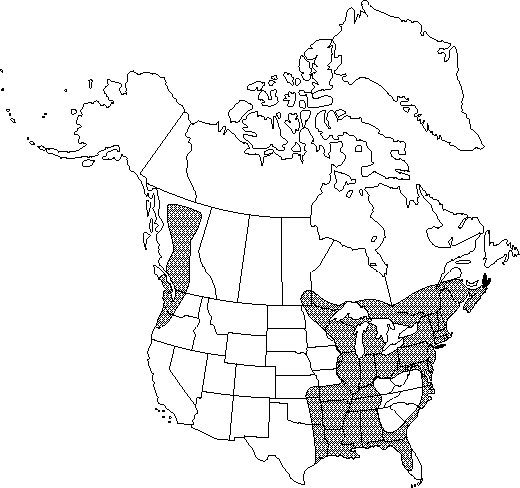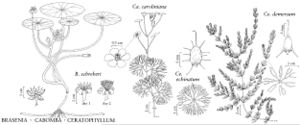Difference between revisions of "Ceratophyllum echinatum"
Ann. Lyceum Nat. Hist. New York 4: 49. 1837.
FNA>Volume Importer |
FNA>Volume Importer |
||
| Line 13: | Line 13: | ||
}}{{Treatment/ID/Special_status | }}{{Treatment/ID/Special_status | ||
|code=F | |code=F | ||
| − | |label= | + | |label=Illustrated |
}}{{Treatment/ID/Special_status | }}{{Treatment/ID/Special_status | ||
|code=W | |code=W | ||
| Line 22: | Line 22: | ||
|name=Ceratophyllum demersum var. echinatum | |name=Ceratophyllum demersum var. echinatum | ||
|authority=(A. Gray) A. Gray | |authority=(A. Gray) A. Gray | ||
| + | |rank=variety | ||
}} {{Treatment/ID/Synonym | }} {{Treatment/ID/Synonym | ||
|name=Ceratophyllum submersum var. echinatum | |name=Ceratophyllum submersum var. echinatum | ||
|authority=(A. Gray) Wilmot-Dear | |authority=(A. Gray) Wilmot-Dear | ||
| + | |rank=variety | ||
}} | }} | ||
|hierarchy=Ceratophyllaceae;Ceratophyllum;Ceratophyllum echinatum | |hierarchy=Ceratophyllaceae;Ceratophyllum;Ceratophyllum echinatum | ||
| Line 50: | Line 52: | ||
-->{{#Taxon: | -->{{#Taxon: | ||
name=Ceratophyllum echinatum | name=Ceratophyllum echinatum | ||
| − | |||
|authority=A. Gray | |authority=A. Gray | ||
|rank=species | |rank=species | ||
| Line 64: | Line 65: | ||
|publication title=Ann. Lyceum Nat. Hist. New York | |publication title=Ann. Lyceum Nat. Hist. New York | ||
|publication year=1837 | |publication year=1837 | ||
| − | |special status=Endemic; | + | |special status=Endemic;Illustrated;Weedy |
| − | |source xml=https://jpend@bitbucket.org/aafc-mbb/fna-data-curation.git/src/ | + | |source xml=https://jpend@bitbucket.org/aafc-mbb/fna-data-curation.git/src/f50eec43f223ca0e34566be0b046453a0960e173/coarse_grained_fna_xml/V3/V3_454.xml |
|genus=Ceratophyllum | |genus=Ceratophyllum | ||
|species=Ceratophyllum echinatum | |species=Ceratophyllum echinatum | ||
Revision as of 21:28, 16 December 2019
Stems to 1 m; apical leaf whorls not densely crowded. Leaves dark green or olive-green, fine-textured. Leaf blade simple or forked into 2-10 ultimate segments (forking of largest leaves 3d or 4th order), proximal segments often conspicuously inflated, mature leaf whorls 25-55 mm diam., marginal denticles weak and inconspicuous, weakly exserted, not raised on broad base of green tissue; 1st leaves of plumule forked. Achene dark green or brown, body (excluding spines) 4.5-6 × 2.5-4.5 × 1.5-3 mm, basal spines 2 (rarely absent), straight or curved, 1-5 mm, marginal spines 2-13, 0.5-6.5 mm, terminal spine straight, 1.5-7.5 mm, margins winged. 2n = 24.
Phenology: Flowering spring–summer.
Habitat: Fresh water of lakes, ponds, marshes, swamps
Elevation: 0-500 m
Distribution

B.C., Man., N.B., N.S., Ont., Que., Ala., Ark., Conn., Del., D.C., Fla., Ga., Ill., Ind., Iowa, Kans., Ky., La., Maine, Md., Mass., Mich., Minn., Miss., Mo., N.H., N.J., N.Y., N.C., Ohio, Okla., Oreg., Pa., R.I., S.C., Tenn., Tex., Vt., Va., Wash., W.Va., Wis.
Discussion
Principally an eastern North American species–and the only species of its genus endemic to North America–Ceratophyllum echinatum is disjunct in the Pacific Northwest as a result of repeated Pleistocene glaciation. The habitats of C. echinatum are typically more acidic (avg. pH 6.6) than those of C. demersum (avg. pH 7.4). The two species only rarely coexist. Ceratophyllum echinatum also thrives in cooler, clearer, and more oligotrophic water than C. demersum and often is found in more ephemeral sites, such as shrub swamps (e.g., with Cephalanthus occidentalis) and beaver ponds.
This species, relatively uncommon, is fast disappearing from much of its range because of habitat alteration or destruction and the introduction of nonindigenous species; steps should be taken to secure its conservation. Unlike Ceratophyllum demersum, C. echinatum does not attain status as a serious weed.
Selected References
None.
